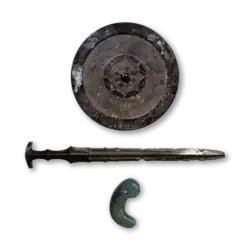草薙剣
Japanese

草薙の剣 (Kusanagi no Tsurugi): Artist's impressions of the (unseen) Imperial Regalia of Japan, with Kusanagi no Tsurugi on the left
| Kanji in this term | ||
|---|---|---|
| 草 | 薙 | 剣 |
| くさ Grade: 1 |
なぎ Jinmeiyō |
つるぎ Grade: S |
| kun’yomi | ||
| Alternative spellings |
|---|
| 草薙劍 (kyūjitai) 草薙の剣 |
Etymology
Phrase consisting of 草 (kusa, “grass”) + 薙 (nagi, “cutting; mowing”, the continuative or stem form of the verb 薙ぐ (nagu, “to cut; to mow”)) + の (no, possessive particle) + 剣 (tsurugi, “double-edged sword”).[1]
The name derives from a legend wherein the sword was used to cut grass, thereby saving the wielder from a deliberately-set fire. See the Wikipedia article for details.
Pronunciation
Proper noun
草薙剣 • (Kusanagi no Tsurugi)
- the "Grasscutting Longsword", one of the three sacred treasures comprising the Imperial Regalia of Japan
Synonyms
See also
References
- Shōgaku Tosho (1988) 国語大辞典(新装版) [Unabridged Dictionary of Japanese (Revised Edition)] (in Japanese), Tōkyō: Shogakukan, →ISBN
- NHK Broadcasting Culture Research Institute, editor (1998), NHK日本語発音アクセント辞典 [NHK Japanese Pronunciation Accent Dictionary] (in Japanese), Tōkyō: NHK Publishing, →ISBN
This article is issued from Wiktionary. The text is licensed under Creative Commons - Attribution - Sharealike. Additional terms may apply for the media files.